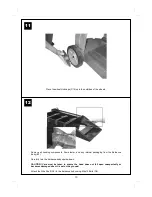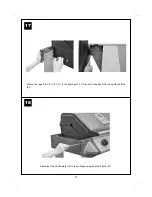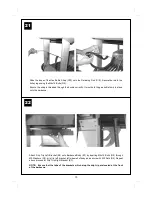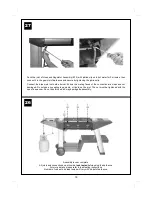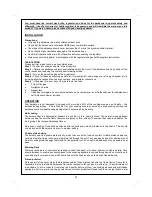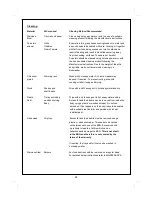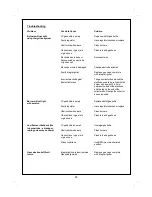
23
Burner Maintenance
Provided that they are operating correctly, in normal usage, burning off the residue after cooking will keep the
burners clean. The burners should be removed and cleaned annually, or whenever heavy build up is found, to
ensure that there are no signs of blockage (fat, debris or insects for example), in either the burner portholes or
the burner primary air inlet. Use a pipe cleaner to clear obstructions. When refitting the burners, be careful to
check that the neck of the burner fits over the valve outlet.
Your burners have been preset for optimal flame performance. You will normally see a blue flame, possibly
with a small yellow tip when the burner is alight. If the flame pattern is significantly yellow, this could be a
problem caused by grease from cooking blocking the burner or spiders or other insects in the burner venturi.
This can result in the flow of the gas and air mixture being restricted or blocked which may result in a fire
behind the control panel causing serious damage to your barbecue.
If this happens, the gas should be
immediately turned off at the bottle.
Burners should be inspected and cleaned on a regular basis in addition
to the following conditions:
•
Bringing the barbecue out of storage.
•
One or more of the burners do not ignite.
•
The burner flame pattern is significantly yellow.
•
The gas ignites behind the control panel.
To clean a burner, remove it from the barbecue. The outside of the burner can be cleaned with a wire brush.
Clean the portholes with a pipe cleaner or piece of wire. Take care not to enlarge the portholes.
Clean the insect screen on the end of the venturi tube with a bristle brush (i.e. an old toothbrush).
Clean the venturi tube with a pipe cleaner or piece of wire. You may need a torch to see into the venturi tube
to make sure it is clear.
Turn the burner up on end and lightly tap against a piece of wood to dislodge any debris from inside.
LPG Hose
The LPG hose does not have a time-limited in-service life but it is essential that the hose and end connections
are regularly inspected and replaced if showing signs of:
•
Physical damage such as – cuts or abrasion, cracking, stretching, flattening or kinking;
•
Environmental deterioration such as – stiffening, cracking, de-lamination of outer covering, chemical
degradation i.e. softening of outer coating by contact with oil;
•
Hose service failure such as – blistering, soft spots, rupture or corrosion or loosening of the swaged fittings
or worm drive clips attaching the hose.
1
2
3
4


